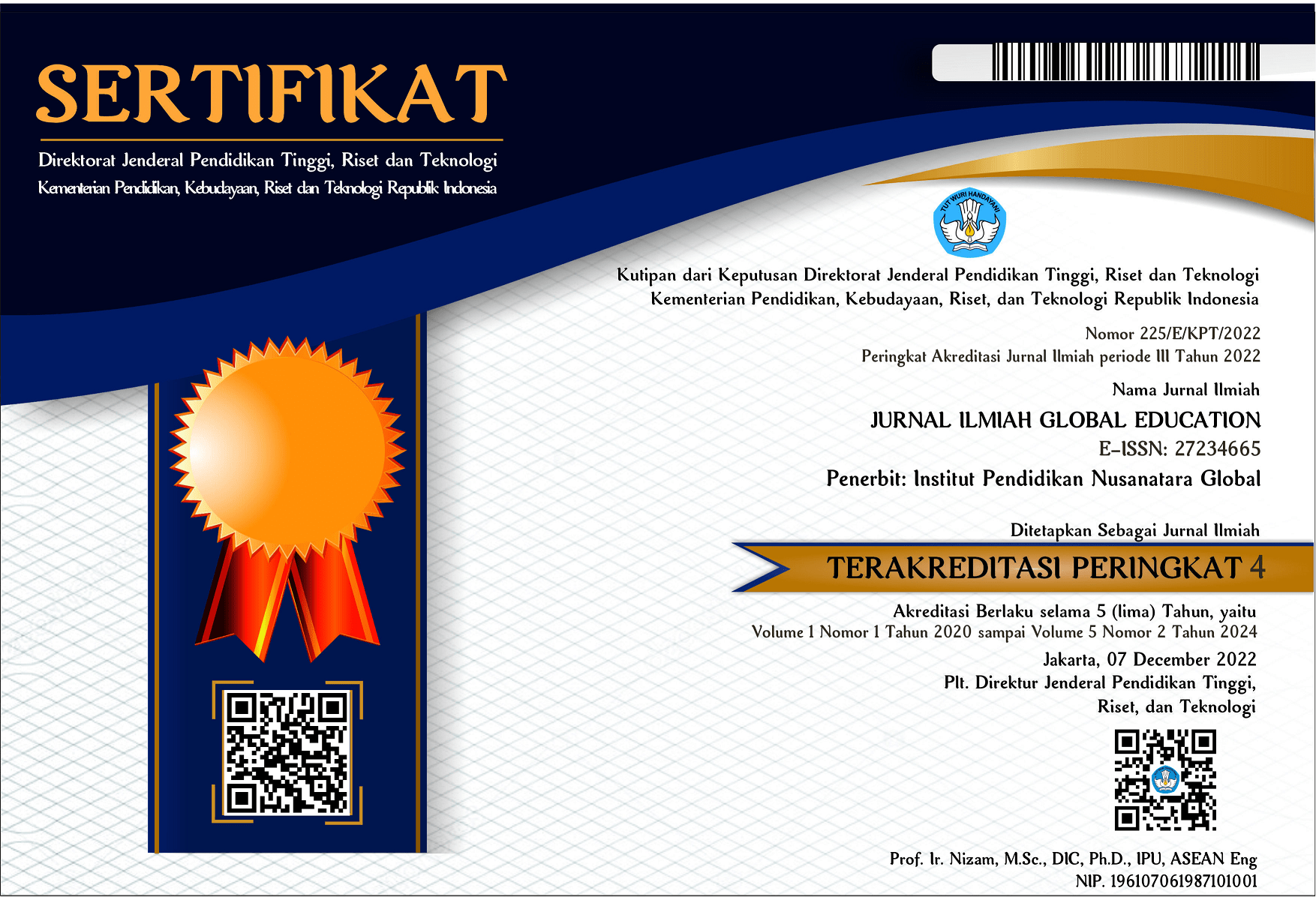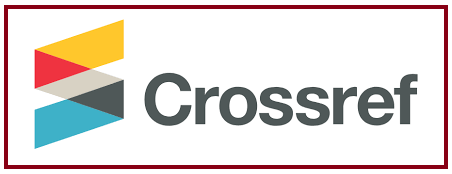REVITALIZATION OF MINAHASAN CULTURE THROUGH VOCABULARY OF TRADITIONAL FOOD NAMES IN THE CONTEXT OF DEVELOPING CULINARY TOURISM IN NORTH SULAWESI PROVINCE
DOI:
https://doi.org/10.55681/jige.v4i1.536Keywords:
Revitalization, Traditional Minahasan food, Form, MeaningAbstract
The research on Revitalization of Minahasan Culture Through Vocabulary of Traditional Food Names in The Context of Developing Culinary Tourism in North Sulawesi Province intends to improve previous research that has been conducted. This research is proposed for one year. The problem formulated in this research is the naming system of Minahasan traditional food and its meaning. This research aims to (1) identify and classify the naming system of traditional Minahasan food, (2) analyze and describe the meaning of traditional Minahasan food names. The specific targets to be achieved in this research are (1) the identification and classification of the naming system of traditional Minahasan food , (2) the identification and classification of linguistic units in the form of words, phrases, and clauses of traditional Minahasan food names, and (3) the results of explanation and description in the form of cultural meaning in linguistic units in the form of words, phrases, and clauses of traditional Minahasan food names. The vocabulary of traditional Minahasan food names as a naming system that has meaning and cultural value based on the cognition of the Minahasan community was found in this study. The origin of food names and the concept of Minahasan culture are also reflected in traditional Minahasan food names. The method used is descriptive qualitative method with an approach through ethnography, synchronic linguistics and gastronomic linguistics methods. Techniques and data collection were observation and interview. The research location is in North Sulawesi Province, especially Minahasan Regency by selecting several cities in the area of North Sulawesi Province by purposive sampling, namely data collection according to research needs. The results of the research are food labeled linulut (food that is inserted in bamboo and burned) and non-linulut (food not in bamboo). The naming system of traditional Minahasann food consists of ingredients, cooking utensils, food makers, places where food is made, the arrival of Minahasann people, and people's names. The form of traditional Minahasann food names consists of words, phrases, and clauses. Pangi, gohu and woku are words. Woku blanga, rica rodo, and Sayor pa'it are phrases. Clauses consist of Ayang woku isi di bulu, Babi woku isi di bulu, and ikang mas bungkus deng daong woka. The meaning of food names is denotative meaning and connotative meaning. The denotative meaning corresponds to the food ingredient, namely pangi. The connotative meaning is the name of the food sende'en, pongkor, fried brot cookies, and Bobengka.
Downloads
References
Aarts dan Aarts. 1978. Grammatical English. New York: McMillan Press.
Adam, I. 1976. Adat-Istiadat Suku Bangsa Minahasan. Jakarta: Bhrarata.
Allan, Keith. 1986. Linguitic Meaning Vol.1. London: Roudledge & Kegan Paul.
Atchinson, J. 1994. Words in Mind. Cambridge: Blackwell publishers.
Aronoff, M and Fudermann, K. 2005. What is Morphology. Maiden: Blackwell Publishing.
Casson, R. 1981. Language, Culture, and Cognition: Anthropological Perspectives. New York: McMillan Publishing Co, Inc.
Clark, E.V. 1993. The Lexicon in Acquitition. Cambridge: Cambridge University Press.
Cruse, D.A. 1991. Lexical Semantics. Cambridge: Cambridge University Ppress.
Deely, J. 1990. Basics of Semiotics. Bloomington & Indianapolis: Indiana University Press.
Fairclough, N. 1989. Language and Power. Relasi Bahasa, Kekuasaan, dan Ideologi. London and New York: Longman Group.
Foley, W. 1997. Anthropological Linguistics in Introduction. USA: Blackwell publisher.
Givon, T. 1984. Syntax: A Functional Typological Introduction. Amsterdam/Philadelphia: John Benjamins Publishing Company.
Halliday, M.A.K dan Ruqaiya, Hasan. 1979. Cohesion in English. London: Longman Group.
Halliday, M.A. K. & Hasan, R. 1985. Language, Context, and Text: Aspect of Language in A Social-Semiotic Perspective. Victoria: Deakin University.
Hickerson, N. 1980. Linguistic Anthropology. New York: Holt, Rhinehart and Winston Inc.
Kalangi, N. 1980. Kebudayaan Minahasan. Dalam Koentjaraningrat (Ed.). Pengantar Ilmu Antropologi. Jakarta:
Karamoy, O. 2002. Peristilahan atau Kosa Kata yang Digunakan Orang Minahasan pada Komuditas Pertanian dalam Pembuatan Makanan Tradisional. Dalam Duta Budaya. No. 53/54. Manado: Fakultas Sastra, Unsrat.
Kempson, D. 1977. Semantic Theory. Cambridge: Cambridge University Press.
Ingkiriwang, J. 2007. Manusia dan Kebudayaan Minahasan. Manado: Percetakan UNSRAT.
Leech, G. 1971. Semantics. London: Penguin Books.
Lehrer, A. 1974. Semantic Fields and Lexical Structure. Amsterdam: North Holland Publishing Company
Lyons, J. 1977. Semantics. I – II. Cambridge: Cambridge University.
Manoppo, G. 1983. Bahasa Melayu Surat Kabar di Minahasan pada Abad ke-19. (disertasi). Jakarta: Universitas Indonesia.
Matthews, P.H. 1978. Morphology: An Introduction to the Theory of the Word-Structure. London: Cambridge University Press.
Miles, M dan Huberman, M. 1992. Analisis Data Kualitatif. Penerjemah Tjetjep Rohidi. Jakarta: UI Press.
Moleong, Lexy J. 1994. Metode Penelitian Kualitatif. Bandung: Remaja Rosdakarya, Offset.
Nida, E. 1975. Componential Analysis of Meaning. The Haque: Mouton
Palmer, E. 1976. Semantics. Great Britain: Cambridge University Press.
Pamantung. R. 2015. Taksonomi Nomina Aspek Makanan dan Minuman Khas Minahasan
Pateda, Mansoer. 2001. Semantik Leksikal. Jakarta: PT Rineka Cipta.
Rondonuwu, B. 1983. Minahasan Tanah Tercinta. Manado: Yayasan Karya Pemuda Sulut, KNPI DPD Minahasan.
Renwarin, R. 2007. Matuari Wo Tonaas. Dinamika Budaya Tombulu di Minahasan. Jilid I: Mawanua. Jakarta: Penerbit Cahaya Pineleng.
Salzmann, Z. 1993. Language, Culture, and Society: Introduction to Linguistic Anthropology. USA: Westview Press.
Samarin, William J.. 1988. Ilmu Bahasa Lapangan. Terjemahan J.S.Badudu. Yogyakarta: Kanisius.
Saeed, J. I. 1999. Lexical Semantics. Massachusets, USA: Blacwell Publishers
Spradley, J. 1979. The Ethnographic Interview New York: Holt, Rinehart and Winston.
Tambahani, J. 2002. Kontribusi Tinu’tuan (Bubur Manado) terhadap Konsumsi Gizi Anak Sekolah Taman Kanak-Kanak di Kabupaten Minahasan Provinsi Sulawesi Utara. Tesis. IPB Bogor
Taulu, H. 1952. Hukum Adatr Minahasan. Tomohon: Yayasan Membangun.
Turang, J. 1997. Profil Kebudayaan Minahasan. Tomohon: Majelis kebudayaan Minahasan.
Ullman, S. 1983. Semantics: An Introduction to the Science of Meaning. Oxford: Basic Blackwell.
Wierzbicka, A. 1996. Semantics Primes and Universals. New York: Oxfprd University.
Weichart, G. 2004. Identitas Minahasan: Sebuah Praktik Kuliner. Dalam Jurnal Antropologi Indonesia: Tahun ke XXVIII No.74, Mei – Agustus 2004.
Wardaugh, E. 1986. Introduction to Sociolinguistics. Oxford: Blackwell Publishers.
Downloads
Published
How to Cite
Issue
Section
License
Copyright (c) 2023 JURNAL ILMIAH GLOBAL EDUCATION

This work is licensed under a Creative Commons Attribution-ShareAlike 4.0 International License.













